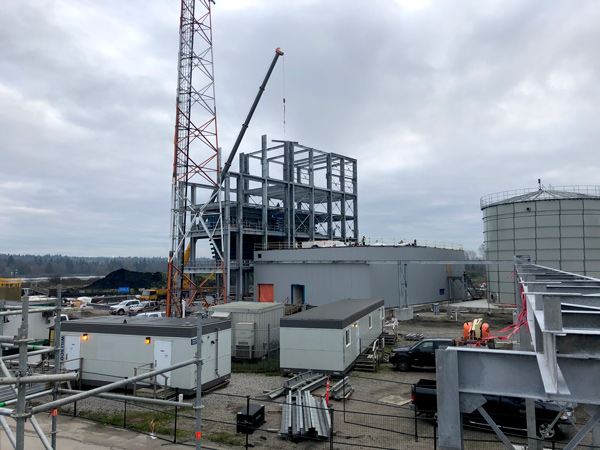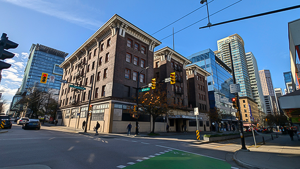NAC Constructors Ltd. is working towards completing a new $52 million bio-solids dewatering facility by fall of 2021 to pave the way for the construction of Metro Vancouver’s new multi-billion dollar Iona wastewater treatment plant (WWTP) that will replace existing 1963-built facility.
The dewater plant is part of what is calls “Phase Zero”, the lead-in to placing a new facility on site, said Richard Stewart, chair of Metro Vancouver’s liquid waste treatment committee. The committee has allocate $6 billion to new capital expenditure projects with the Iona WWTP replacement project dominating expenditures and targeting completion by 2030 with a six-year construction period. Phase One of construction is targeted to start in 2024.
The new and existing treatment plants are both situated on Iona Island, part of the City of Richmond, located in the North Arm of the Fraser River with a causeway linking it to Sea Island while the north face it is across from the Musqueam Reserve. Richmond’s website said the areas was “a little more than a large sand bar” that served the farming community until the treatment plant and regional park were established on the island.
Phase Zero includes clearing a building site next to the existing Iona facility, decommission existing lagoons, and providing the new dewatering facility to replace the lagoons. While the new facility will have a smaller footprint, it will enhance wastewater treatment to the highest tertiary standard and recoup resources found within the sewage.
“We are going to be mining the effluent,” said Richard Stewart, chair of Metro Vancouver’s liquid wastewater treatment committee.
The plans for the new plant undertaken by Metro Vancouver will see a heat recovery system, a bio-gas collection system and bio-solids recovery for use in land reclamation and landscaping. As well, Metro Vancouver has a pilot project converting sewage sludge into bio-crude occurring at Annacis Island and if successful, the same initiative will be incorporated into the new project, Stewart said. (See side bar on the bio-crude plant, the first of its kind in the world).

“It (Iona replacement) will be largest infrastructure project we have undertaken,” said Stewart, with the project green-lighted in mid-2020. Currently, the project is in preliminary design with the board expected to approve the preliminary design by spring 2021, leading to detailed engineering designs. “It will take a year and once we get all of the detailed design, then we will be going out to tender on the various phases,” said Stewart.
The new plant will have the advantage of dealing with a purer feed stream of sewage as the Vancouver, UBC endowment lands, parts of Burnaby and Richmond will have conformed to the new 2030 provincial standard to separate storm water from sewage. The new plant will handle the same volume but be better able to capture resources from the effluent. .
Stewart said that part of Phase Zero is dealing with large stacks of old bio-solids stored on site. Iona was built at a standard that only required primary treatment of wastewater, which sees sewage go through screens to remove large objects such as wood, rags and then bio-solids in the effluent settle down to the bottom before the remaining liquid going to a digester. The settled bio-sludge is directed to the lagoons at the Iona site. When evaporation occurs remaining what remains are bio-solids, which are removed and stored on site.
“We have a legacy of solids stockpiles and we need to remove them,” said Stewart. Metro Vancouver estimates that there are 200,000 tons of bio-solids on site that have to be removed with trucks now hauling the material away. In early February, there remained 180,000 tons to be taken to gravel pits, mine reclamation projects or used for landscaping.
Once the dewatering plant is finished, the lagoons can be decommissioned.
Peter Navratil, Metro Vancouver’s liquid waste general manager, said the current dewatering plant under construction uses a centrifugal drum which will spin excess water from the bio-solids. Once these are de-watered, the bio-solids are feed into a hopper for loading onto trucks to be removed.
Navratil estimates that because the Iona WWTP project is such a large undertaking and involves various aspects of resource harvesting, it will be tendered in a number of phases for construction. Until a final design is completed the price and completion schedule of the new plant is unknown.
Site geology is expected to be a challenge. Navratil said site densification has to be done to accommodate the new treatment plant. Phase 1 will be ground improvement and the plant foundations, he said, adding that these are not expected to start until 2024 when the site is cleared, Navratil estimates. Since the island is largely sand, the detail final design will require it to rest on sand, he said, and continue to remain stable in the event of an earthquake. “Half your (construction) time will be in ground preparation and the other half in building the plant,” Navratil said.











Recent Comments
comments for this post are closed